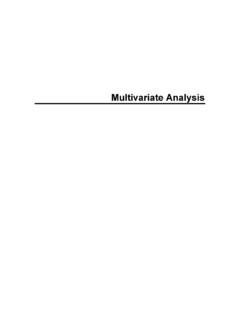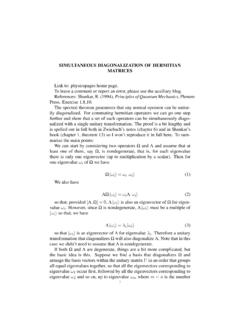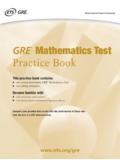Transcription of Level-slope-curvature – fact or artefact?
1 1 Level-slope-curvature fact or artefact ? Roger Lord1 Antoon Pelsser2 First version: September 29th, 2004 This version: January 29th, 2006 ABSTRACT The first three factors resulting from a principal components analysis of term structure data are in the literature typically interpreted as driving the level, slope and curvature of the term structure. Using slight generalisations of theorems from total positivity, we present sufficient conditions under which level, slope and curvature are present. These conditions have the nice interpretation of restricting the level, slope and curvature of the correlation surface. It is proven that the Schoenmakers-Coffey correlation matrix also brings along such factors.
2 Finally, we formulate and corroborate our conjecture that the order present in correlation matrices causes slope . Keywords: Principal components analysis, correlation matrix, term structure, total positivity, oscillation matrix, Schoenmakers-Coffey matrix. JEL classification: C50, C60, G10. The authors would like to express their gratitude to Abdel Lantere for some valuable insights. Thanks also go out to Allan Pinkus, Peter van de Ven, Olivier Laseroms, Frank Bervoets and finally Jan Brinkhuis, Maarten Janssen and Thierry Post for the organisation of the Unfinished Manuscripts seminar at the Erasmus University Rotterdam, where the idea for this paper was initially presented by the second author.
3 We are grateful to seminar participants at Rabobank International, the Tinbergen PhD lunch seminars and the Quantitative Methods in Finance 2005 conference in Sydney for fruitful comments. 1 Tinbergen Institute, Erasmus University Rotterdam, Box 1738, 3000 DR Rotterdam, The Netherlands (e-mail: Tel. +31-(0)10-4088935) and Modelling and Research (UC-R-355), Rabobank International, Box 17100, 3500 HG Utrecht, The Netherlands (e-mail: Tel. +31-(0)30-2166566). 2 ING Group, Corporate Insurance Risk Management, Box 810, 1000 AV Amsterdam, The Netherlands and Erasmus University Rotterdam, Econometric Institute, Box 1738, 3000 DR Rotterdam, The Netherlands (e-mail: Tel.)
4 +31-(0)10-4081258). 21. Introduction In an attempt to parsimoniously model the behaviour of the interest rate term structure, many studies find that using the first three principal components of the covariance or correlation matrix already accounts for 95-99% of the variability, a result first noted for interest rate term structures by Steeley [1990] and Litterman and Scheinkman [1991]. These results were also found to hold for the term structure of copper futures prices by Cortazar and Schwartz [1994], and also for the multiple-curve case, as shown by Hindanov and Tolmasky [2002]. This paper does not deal with the question of how many factors one should use to model the interest rate term structure, or any term structure for that matter, but addresses the shape of the first three factors.
5 The shape hereof is such that many authors, starting from Litterman and Scheinkman, have attached an interpretation to each of these three factors. The first factor, or indeed eigenvector of the covariance or correlation matrix, is usually relatively flat. As such it is said to determine the level or trend of the term structure. The second, which has opposite signs at both ends of the term structure, can be interpreted as determining the slope or tilt. The third factor finally, having equal signs at both ends of the maturity spectrum, but an opposite sign in the middle, is said to determine the curvature , twist or butterfly of the term structure. A question that comes to mind is whether the observed pattern is caused by some fundamental structure within term structures, or whether it is merely an artefact of principal components analysis (PCA).
6 Alexander [2003] in fact claims that .. the interpretation of eigenvectors as trend, tilt and curvature components is one of the stylised facts of all term structures, particularly when they are highly correlated . In this paper we investigate sufficient conditions under which the Level-slope-curvature effect occurs. To the best of our knowledge only one article has so far tried to mathematically explain this Level-slope-curvature effect in the context of a PCA of term structures, namely that of Forzani and Tolmasky [2003]. They demonstrate that when the correlation between two contracts maturing at times t and s is of the form |t-s|, where is a fixed positive correlation, the observed factors are perturbations of cosine waves with a period which is decreasing in the number of the factor under consideration.
7 This correlation function is widely used as a parametric correlation function in the LIBOR market model, see Rebonato [2002]. In fact , Joshi [2000,2003] analyses a stylised example with three interest rates, which sheds some light on the conditions for the occurrence of an exponentially decaying correlation function; the same analysis is included in Rebonato [2002]. We formulate the Level-slope-curvature effect differently than Forzani and Tolmasky. As noted, the first factor is quite flat, the second has opposite signs at both ends of the maturity spectrum, and the third finally has the same sign at both ends, but has an opposite sign in the middle.
8 This observation leads us to consider the number of sign changes of each factor or eigenvector. If the first three factors have respectively zero, one and two sign changes, we say that we observe level, slope and curvature . Obviously this is only a partial description of the Level-slope-curvature effect, as the sign-change pattern does not necessarily say anything about the shape of the eigenvectors. However, if we want to analyse a general correlation matrix, choices have to be made. Using a concept named total positivity, Gantmacher and Kre n considered the spectral properties of totally positive matrices in the first half of the twentieth century.
9 One of the properties of a sub-class of these matrices, so-called oscillation matrices, is indeed that the nth eigenvector of such a matrix has exactly n-1 sign changes. These results can be found in their book [1960, 2002]. With a minor generalisation of their theorems, we find sufficient conditions under which a term structure indeed displays the Level-slope-curvature effect. The conditions have the nice interpretation of placing restrictions on the level, slope and curvature of the correlation curves. 3 Subsequently we turn to a correlation parameterisation which was recently proposed by Schoenmakers and Coffey [2003]. In matrix theory the resulting correlation matrix is known as a Green s matrix.
10 The exponentially decreasing correlation function considered by Forzani and Tolmasky is contained as a special case of the Schoenmakers-Coffey parameterisation. The resulting correlation matrix has the nice properties that correlations decrease when moving away from the diagonal term along a row or a column. Furthermore, the correlation between equally spaced rates rises as their expiries increase. These properties are observed empirically in correlation matrices of term structures. Gantmacher and Kre n derived necessary and sufficient conditions for a Green s matrix to be an oscillation matrix, and hence to display level, slope and curvature .





